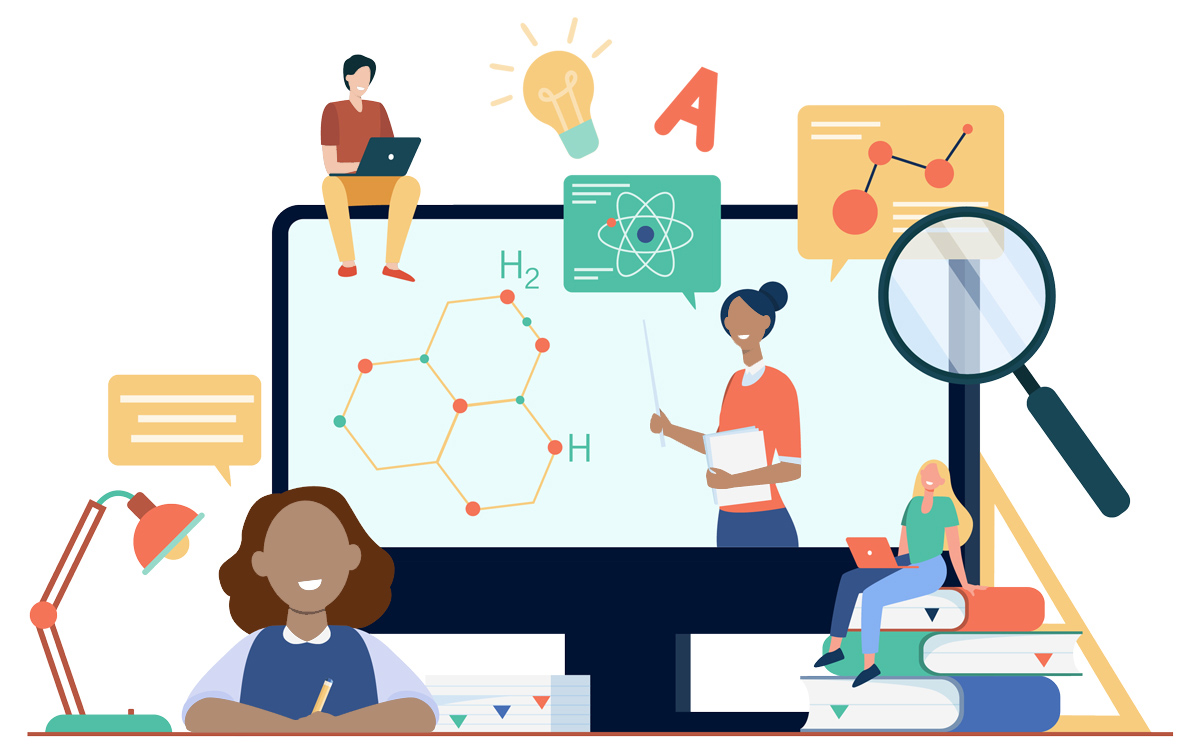The call for designers who can create digital experiences that support learning and teaching is stronger than ever. That’s because digital learning experiences are ubiquitous — from a middle school classroom to onboarding new employees to continuing education.
But what is digital learning?
In short, it’s learning that is enabled or facilitated through technology, namely computers, mobile devices, and tablets. Organizations often use learning management systems (such as Blackboard, Moodle, and Canvas), to organize digital learning content, including lectures, videos, discussion forums, etc. For example, an instructor may want to pair live instruction with a video that must be viewed or an online module that must be completed prior to the session.
Through digital learning, designers can create more engaging, interactive, and immersive learning experiences. It’s often driven by student data and feedback, which allows the learning experience to evolve as needed for better results. Finally, designers should consider multiple elements: How easy is the environment to navigate? What does it look like from an aesthetic standpoint? How functional is it? How accessible is it to users of all abilities? Does it help achieve learning objectives and result in increased learner success?
Digital Learning Design vs. Instructional Design
Quality digital learning involves applying instructional design principles. Instructional design is the systematic design of learning content and instruction, and it provides the tools for applying learning science to instructional products. What’s unique about digital learning design is its use of technology to engage learners and communicate key concepts. Designed effectively, digital learning cultivates opportunities for learning content in ways that are only possible with the use of digital technology. Designers work closely with colleagues to deliver high-quality learning activities through online, hybrid, or blended learning formats.
For optimal results, designers must incorporate evidence-based curricular and pedagogical practices to create meaningful teaching and learning experiences. This entails thinking about who the learners are, what they want to learn, and how they want to learn. It also involves exploring ways to foster creativity, exploration, and discovery within these systems. Finally, it requires looking at the entire learning experience from planning and design to delivery and assessment. Without an understanding of best instructional design practices, designers are less likely to build digital learning tools that effectively engage and teach learners.
Understanding these principles also makes it easier to comprehend how to use and adapt technology to address diverse learner needs. For example, if gamification is a method you wish to deploy, the question becomes which technology platform or tool is best suited to facilitate that learning experience?
Accessibility is Key
The challenge with digital learning is to create accessible, user-centered learning experiences that are consistent regardless of location and device. It is also important to note that while digital learning is meant to contribute to equitable learning opportunities, participants may experience “access, use, and design” divides (U.S. DOE, Office of Educational Technology, 2024, p. 8).
When designing learning content, here are a few things to keep in mind, such as how easy it is to:
- maintain, update, or adopt the platform?
- use on an older computer or device?
- use on all operating systems and browsers without experiencing bugs or security issues?
- navigate the course or platform?
- share materials within the system in multiple places and ways?
- provide access to content for those with physical or learning disabilities?
Getting Started in the Digital Learning Design Field
Classrooms aren’t limited to academic classrooms — they can also include corporate boardrooms, government agencies, and military training. Really, wherever human performance and learning take place, educational technology can play a supportive role — which means there are increasing opportunities for digital learning designers.
Most people who pursue this field have a background in education, instructional design or educational technology. They have an interest in ed tech and are curious about how different applications can be used to enhance instruction, whether it be in a K-12 school, a university, or a corporate or non-profit organization. But at the end of the day, good digital learning is simply good learning.
If you’re interested in developing new and engaging approaches to learning and teaching practices, an advanced degree or certificate may be the path forward for you. At the George Washington University Graduate School of Education and Human Development (GSEHD), students can choose from a master’s program, a certificate program, or a joint degree program in Educational Technology Leadership. Reach out to an %20askdel![]() gwu [dot] edu (admissions coach) today!
gwu [dot] edu (admissions coach) today!




